Book contents
- Frontmatter
- Prelude: Jesus Christ, foundation of Christianity
- Part I The Political, Social and Religious Setting
- Part II The Jesus Movements
- Part III Community Traditions and Self-Definition
- 8 The emergence of the written record
- 9 Marcion and the ‘canon’
- 10 Self-definition vis-à-vis the Jewish matrix
- 11 Self-definition vis-à-vis the Graeco-Roman world
- 12 Self-differentiation among Christian groups: the Gnostics and their opponents
- 13 Truth and tradition: Irenaeus
- 14 The self-defining praxis of the developing ecclēsia
- Part IV Regional Varieties of Christianity in the First Three Centuries
- Part V The Shaping of Christian Theology
- Part VI ‘Aliens’ become Citizens: towards Imperial Patronage
- Conclusion: retrospect and prospect
- Bibliographies
- Index
- Map 1. The Roman Empire in the time of Marcus Aurelius
- References
9 - Marcion and the ‘canon’
from Part III - Community Traditions and Self-Definition
Published online by Cambridge University Press: 28 March 2008
- Frontmatter
- Prelude: Jesus Christ, foundation of Christianity
- Part I The Political, Social and Religious Setting
- Part II The Jesus Movements
- Part III Community Traditions and Self-Definition
- 8 The emergence of the written record
- 9 Marcion and the ‘canon’
- 10 Self-definition vis-à-vis the Jewish matrix
- 11 Self-definition vis-à-vis the Graeco-Roman world
- 12 Self-differentiation among Christian groups: the Gnostics and their opponents
- 13 Truth and tradition: Irenaeus
- 14 The self-defining praxis of the developing ecclēsia
- Part IV Regional Varieties of Christianity in the First Three Centuries
- Part V The Shaping of Christian Theology
- Part VI ‘Aliens’ become Citizens: towards Imperial Patronage
- Conclusion: retrospect and prospect
- Bibliographies
- Index
- Map 1. The Roman Empire in the time of Marcus Aurelius
- References
Summary
Marcion is one of the most intriguing yet elusive figures in early Christian history. It is proof of his prominence that, among the diverse forms of Christianity that flourished in the second century, his was the most frequently and forcefully attacked by anti-heretical writers, and was apparently perceived as the most dangerous. Marcion has likewise interested modern scholars, not only because of the peculiarities of his teachings but also because of his possible influence on one of the most important developments in the early church, the formation of the Christian Bible. In that connection, Marcion has commanded attention on two major topics: the church’s appropriation of the scriptures of Judaism (which it came to call the ‘Old Testament’), and the emergence of a canon of specifically Christian scriptures (a ‘New Testament’).
It is impossible in short space to do justice to the many difficulties that beset the study of Marcion and his influence. It has not yet become entirely clear either what Marcion taught or why he taught it. Some of his salient convictions are well known, but it remains uncertain how they arose, cohered or intersected the convictions of others. The old question whether Marcion should be regarded as a biblical theologian or as a Gnostic (or philosophical) teacher has not been answered, and cannot be answered in those terms. But, by situating Marcion within second-century Christianity and the issues that preoccupied it, we can go far towards making his activity intelligible and evaluating his role.
Keywords
- Type
- Chapter
- Information
- The Cambridge History of Christianity , pp. 195 - 213Publisher: Cambridge University PressPrint publication year: 2006
References
- 9
- Cited by



